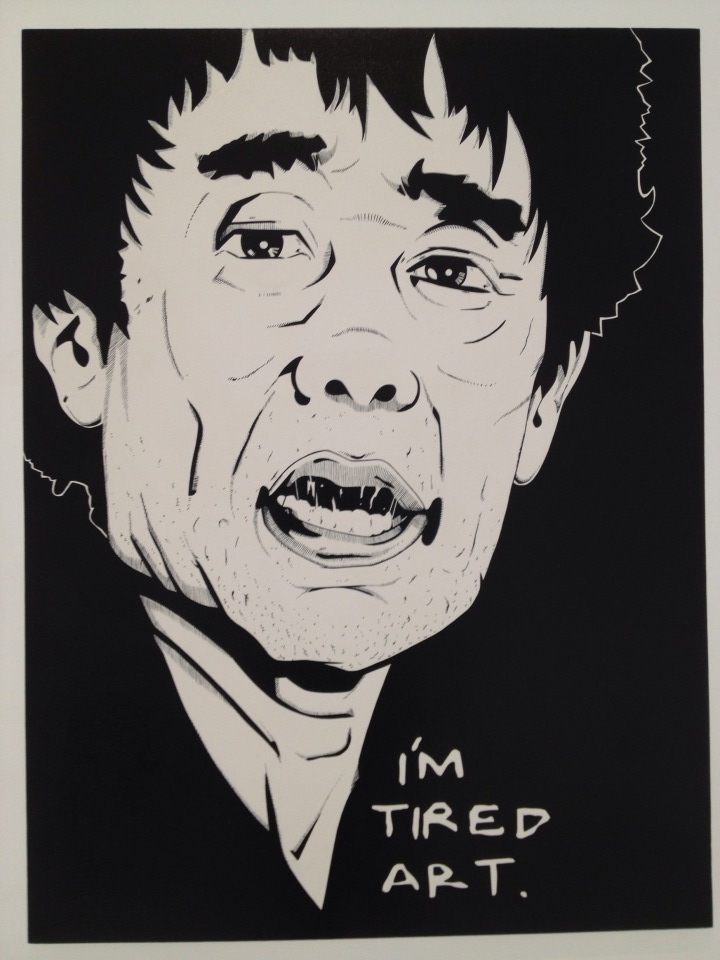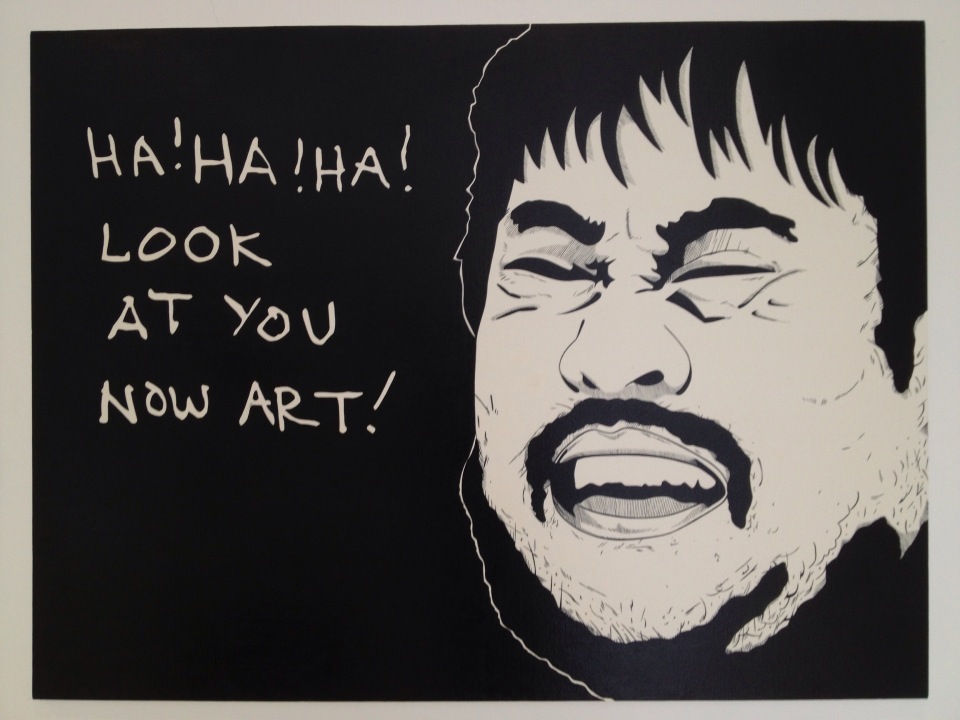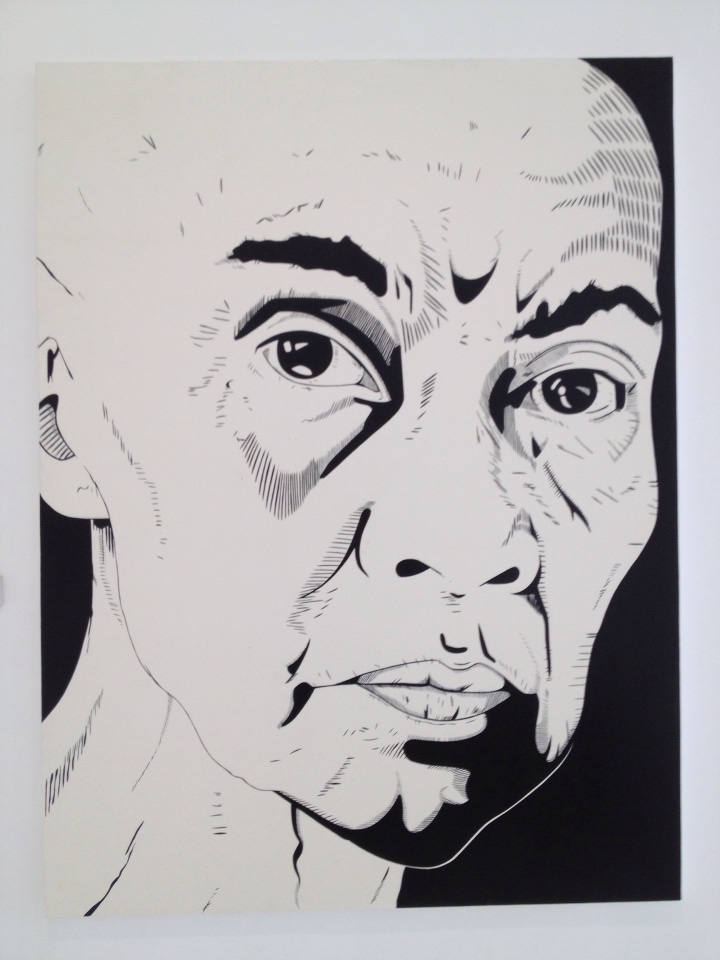It was jarring to enter the individual space for Ronald Caringal’s recent exhibit, to find all but nine images that look like comic book illustrations. All in black and white, these are close-ups of faces, familiar but not exactly someone you’d know. They are all speaking, some more adamant, more frustrated, more incensed than others. Other faces have lips pursed, eyes looking out to the spectator, spoken for by the words emblazoned within the canvas.
The story unfolds.
The story of art
Caringal’s exhibit is in fact made up of nine oil on canvas paintings, that appropriate the images of a comic book for good reason: this exhibit as a whole is having some drama with art. Which is of course to say that art is made human here by the kind of conversation that the exhibit’s characters are having with it.
The title of each work here is like an introduction to, a premise for, the question or statement that the work is throwing at art as a person. Each title happens in the form of regret, or of surrender, if not of a taking stock of the way things are: art is speaking in those titles, as it is being spoken to in the works themselves.
There is a structure in this exhibit that one rarely sees in exhibits, where it obviously works with a narrative, one that it consciously and deliberately tells. The only way to go through this exhibit, is to follow the path that the artist has written for it. One work after another, one wall after another. 
The drama of / with art
The first of the works is entitled “I used to be immortal.” It corresponds to the image of a woman with sad eyes, lips half-open, and the words: “Art, It’s Over.” Art as such is the object of disaffection; the “I” in that title has realized it is not immortal, and that it can be deemed over and done with. Art is dead.
“I used to have all the energy in the world” corresponds to an image that has an old man, mouth agape in speech, saying “I’m tired, Art.” This shift to the artist’s voice, talking to art, talking about the artist’s exhaustion, is powerful in that image of the old man: eyes tired, face wrinkled, head of hair unkempt. In “I used to have all the courage I needed” meanwhile, art is being told “No.” Another old man, hair all white, mouth barely open, looking straight out at the spectator, is saying “No, Art, No.” The effect is one of surrender, of having tried but failed, of having been tired out by the task of courage.
In “I used to know were I was at all times” the “I” is connected to having lost art, or to the task for realizing that it is missing. The corresponding image is that of a girl, teary-eyed with mouth a-quiver, asking “Where Is Art?”
If this exhibit is any indication it is nowhere to be found.
Distress and laughter with / by art
The next three pieces would traverse the line between serious and humorous, where the crises in each title-painting combination speak of a seeming dismay, the kind that one can only shake one’s head at.
In “I used to be heard” the image is that of a bearded man at the height of a scream, eyes closed in anger, facial hair blending into the black backdrop. He is screaming “Aaaaart!” in a combination of anger and pain. The next canvas is entitled “I used to think I not going to be alone” where the image is that of a man, mouth agape, saliva and all, eyes wide open, speaking loud and clear: “Go away Art, No one’s here.”
The next canvas holds the image of a man laughing out loud, with the words “Hahaha! Look at you now Art!” The title says “I used to believe there was something there,” highlighting how this is in fact a conversation between one who thought highly of art, how imagined it to be valuable, or important; and another who laughs at it, rendering it a failure, if not something that’s now irrelevant.
The effect of these three canvases vis a vis the first four conversations is that of climax. In these three, there is a sense of a real disenfranchisement between artist and art, if not within the creative process that the conversation of title-painting highlights. There is no love affair, no romance, not even enough of longing or desire for any of it to be compassionate. There is nothing but distance.
Loss in and with art
The next image is unique because it is without words. It is just the image of an old woman, her head bald, her face wrinkled. Her questioning eyes look out of the canvas, her lips are pursed, her brows furrowed. The title of the image is “I used to have a son.”
The shift to the personal is something that is startling at the very least; painful at best. It is a shift that is beyond art, and is within the realm of sacrifice, where the loss of another is beyond art, but has everything to do with its making. At this point in the exhibit too, curated as it was in this way, it is clear that the narrative is at the point of despair and regret. The image of the old woman, is painful because it is aged, and because it speaks of an inability to regain what was lost.
Which is also in the last piece in this exhibit. Entitled “I used to know who I was,” this carries the lone image that isn’t facing the spectator squarely and looking her in the eye. Instead there is a woman here, looking to someone on her right, and asking “Is that you Art?” More than that question is the tone in which it is asked, as if someone familiar has become stranger, as if the stranger might be familiar.
The effect of these last two paintings is a form of haunting, where the narrative is about one that has been lost to art, or art being lost in and by itself, both of which speak of that line drawn between rational and crazed, the humor in the other paintings suddenly borne of a seeming instability in this exhibit’s telling.
But of course the task of talking to oneself, especially when that other self is art, speaks of this instability not as something that this exhibit failed to see, but as something that it sought to discuss and engage with. In the end and ultimately measuring itself against the instability that is in art and its making, the artist and his becoming.
Ronald Caringal’s “I used to be able to talk to myself. Now we just argue.” was up at Blanc Gallery Katipunan, September 2013. All photos of Caringal’s works taken by me.



“on “I used to be able to talk to myself. Now we just argue.
” | RadikalChick” really got me simply addicted with ur
web-site! I reallywill certainly be returning much more normally.
Thanks a lot ,Callum